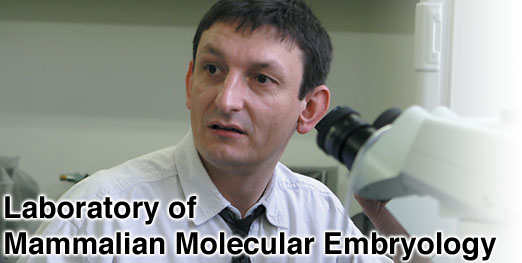





      |

Tony PERRY Ph. D.
There can be few, if any, cells as specialized as sperm and egg; they appear unique (you can even see a mammalian oocyte with the naked eye) and don't typically divide by themselves. Yet when mammalian sperm and egg combine at fertilization, the single cell they generate is transformed within hours into a totipotent cell: one from which all cell types develop to produce an entire individual.
Our laboratory combines molecular and cell biology with micromanipulation of mouse gametes and embryos to study the nuclear and cytoplasmic events that occur immediately after sperm-egg union (oocyte activation) and their developmental consequences. One long-standing question concerns why oocytes don't begin to divide by themselves in the absence of a sperm. To address this, we developed a novel approach that revealed that the removal of the protein Emi2 from oocytes caused them to resume the cell cycle as if they had been activated by a sperm. We then extended this to show that Emi2 works through Cdc20 and that both parthenogenetic activation and fertilization require Cdc20. This may be the first formal demonstration that the signaling required for parthenogenesis and fertilization has molecular components common to both, which is significant given the application of parthenogenetic activation to nuclear transfer.
During meiotic resumption, sperm chromatin undergoes almost complete remodeling; its nucleoproteins, which are mostly protamines, are removed and supplanted by maternal histones which are subsequently modified. We study and manipulate this overall process and have found that chromatin remodeling varies depending on the provenance of the nucleus; the fate of somatic cell chromatin is different from chromatin associated with a sperm-derived genome, even when both are in the same oocyte. Moreover, chromatin remodeling is not necessarily of critical importance; gross hyper-acetylation during fertilization does has only a limited effect, if any, on development.
We are interested in additional interactions between sperm head components and the oocyte cytoplasm, in a bid to discover what happens during fertilization and the earliest moments of the new embryo. It would be useful to attribute molecular identities to the proteins involved in these interactions and characterize them functionally. This task is a daunting one, as the sperm contributes >1000 distinct nuclear and cytoplasmic protein species at fertilization, and yet detecting them in newly fertilized oocytes and embryos requires exquisitely sensitive methods. With a greater understanding of any sperm contribution to development, our lab hopes to gain insights into the processes by which embryonic stem cells are formed and carcinogenesis is initiated.